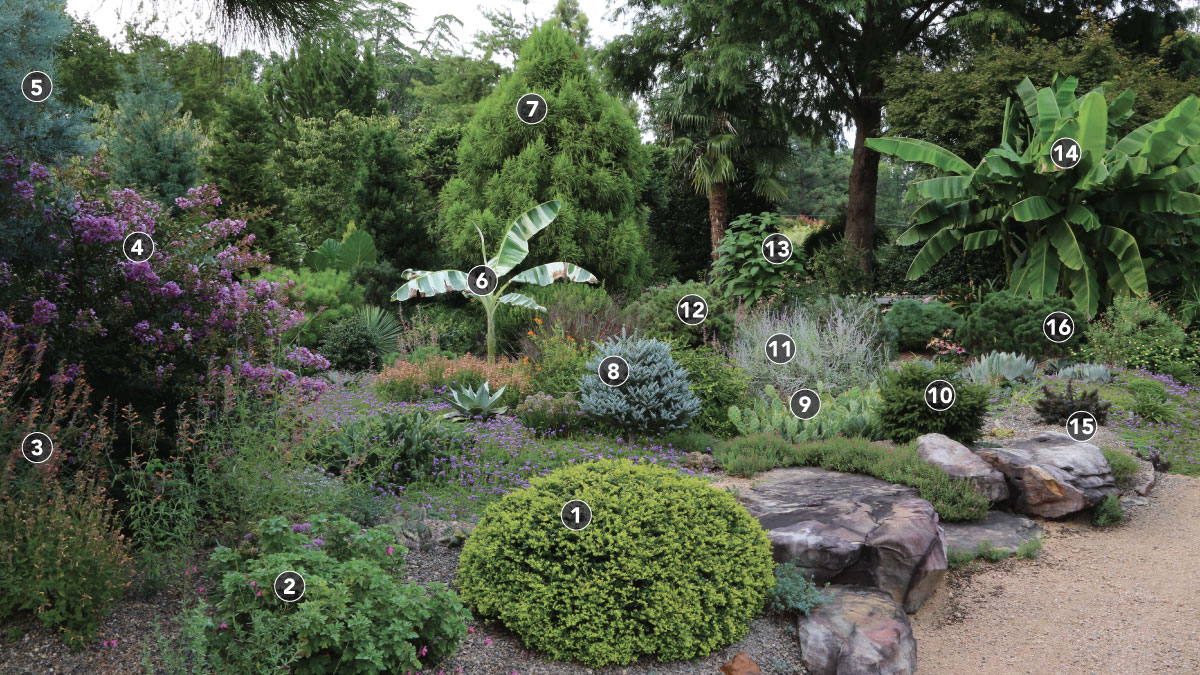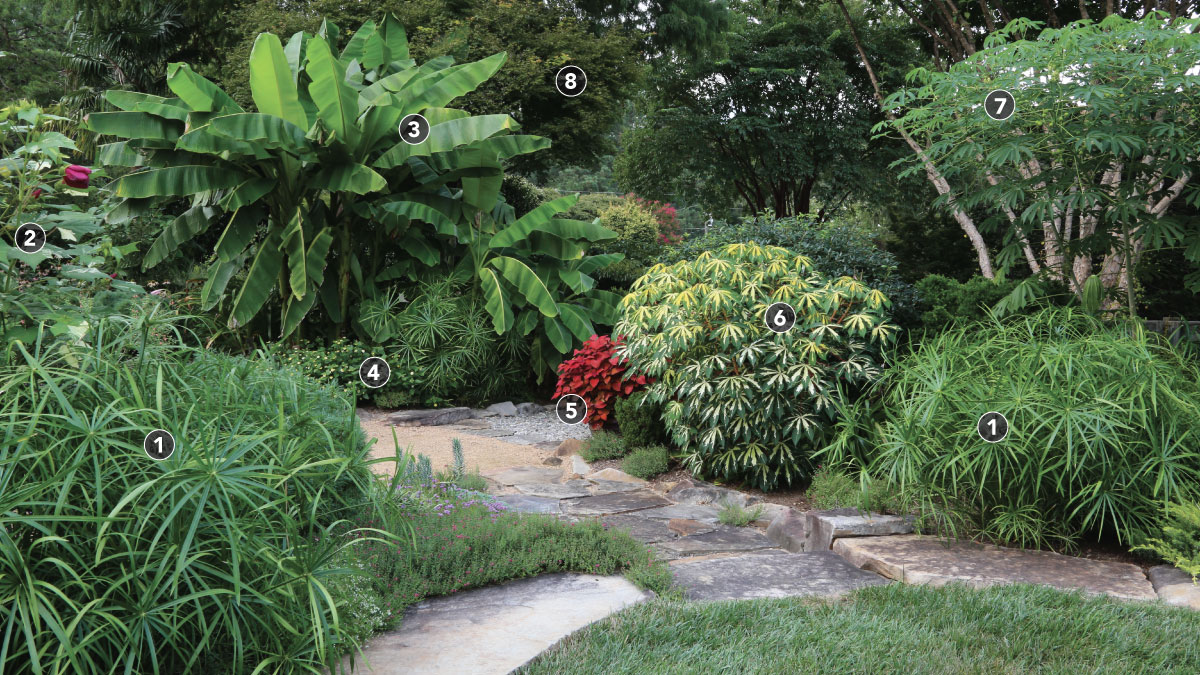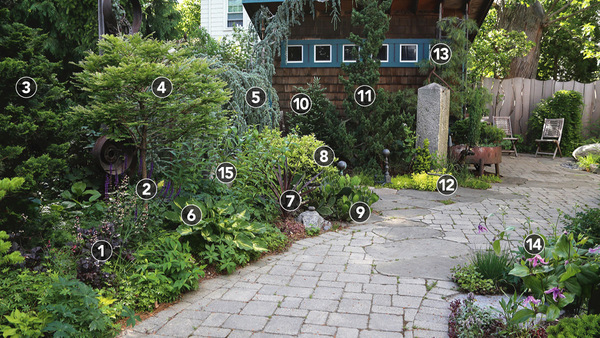
The garden of Joann Currier and Sebastian Hamilton in North Carolina is a study in textures. At every turn you see another plant—be it a perennial, conifer, or even cactus—that exhibits spectacular texture. The plant pairing made by these gardeners is masterful: Smooth-leaved agaves are matched with spiky dwarf pines. It doesn’t take long for this Zone 7 garden to inspire visitors, all of whom want to know the name of each and every plant. The following are some of the featured stars from this varied landscape.
Plant IDs
(Each list corresponds to the photo above it.)
1. Oregano (Origanum spp. and cvs., Zones 4–8)
2. ‘Lavender Frappe’ verbena (Verbena catherinae ‘Lavender Frappe’, Zones 7–10)
3. ‘Grune Kugel’ Western red cedar (Thuja plicata ‘Grune Kugel’, Zones 5–8)
4. ‘Girard Dwarf’ Japanese black pine (Pinus thunbergii ‘Girard Dwarf’, Zones 5–8)
5. ‘Golden Ghost’ Japanese red pine (Pinus densiflora ‘Golden Ghost’, Zones 2–7)
6. Red yucca (Hesperaloe parviflora, Zones 5–10)
7. Whale’s tongue agave (Agave ovatifolia, Zones 7–11)
8. Pugster Blue®butterfly bush (Buddleia ‘SMNBDBT’, Zones 5–9)
9. Hyssop (Agastache cv., Zones 5–9)
10. ‘Pixie’ Japanese maple (Acer palmatum ‘Pixie’, Zones 5–9)
11. Korean fir (Abies koreana, Zones 5–7)
12. ‘Jade’ Hinoki false cypress (Chamaecyparis obtusa ‘Jade’, Zones 4–8)
13. ‘Margaritaville’curve-leaf yucca (Yucca recurvifolia ‘Margaritaville’, Zones 7–9)
14. ‘McFetter’ alligator juniper (Juniperus deppeana ‘McFetter’, Zones 7–9)
15. Dwarf loblolly pine (Pinus taeda ‘Nana’, Zones 6–9)
1. ‘Golden Helleri’ Japanese holly (Ilex crenata ‘Golden Helleri’, Zones 6–9)
2. Garden mum (Chrysanthemum cv., Zones 4–9)
3. Hyssop (Agastache cv., Zones 5–9)
4. ‘New Orleans’ crape myrtle (Lagerstroemia ‘New Orleans’, Zones 6–10)
5. ‘McFetter’ alligator juniper (Juniperus deppeana ‘McFetter’, Zones 7–9)
6. Royal variegated banana (Musa ‘Ae Ae’, Zones 10–11)
7. ‘Yellow Twig’ Japanese cedar (Cryptomeria japonica ‘Yellow Twig’, Zones 5–9)
8. ‘Siberlocke’ Korean fir (Abies koreana ‘Siberlocke’, Zones 5–7)
9. Eastern prickly pear (Opuntia humifusa, Zones 4–9)
10. Dwarf Norway spruce (Picea orientalis ‘Nana’, Zones 4–7)
11. Russian sage (Perovsikia atriplicfolia, Zones 5–9)
12. ‘Watereri’ Scots pine (Pinus sylvestris ‘Watereri’, Zones 3–7)
13. Angel’s trumpet (Brugmansia cv., Zones 9–11)
14. Hardy banana (Musa basjoo, Zones 5–10)
15. ‘Black Beauty’ false petunia (Ruellia ‘Black Beauty’, Zones 7–8)
16. ‘Pal Maleter’ mugo pine (Pinus mugo ‘Pal Maleter’, Zones 2–8)
1. ‘Baby Tut’ umbrella plant (Cyperus involucratus ‘Baby Tut’, Zones 9–11)
2. ‘Gold Splash’ hibiscus (Hibiscus mutabilis ‘Gold Splash’, Zones 8–10)
3. Hardy banana (Musa basjoo, Zones 5–10)
4. Lucky® Lemon Glow lantana (Lantana ‘Balucemlow’, Zones 8–11)
5. ‘Campfire’ coleus (Plectranthus scutellarioides ‘Campfire’, Zone 11)
6. Variegated bitter cassava (Manihot esculenta ‘Variegata’, Zones 10–11)
7. Hardy tapioca (Manihot grahamii, Zones 7–10)
8. Japanese maple (Acer palmatum cv., Zones 5–9)
To learn more about designing with texture, check out the full Texture Never Quits article.
Danielle Sherry is the senior editor.
Photos: Danielle Sherry.




















Comments
Log in or create an account to post a comment.
Sign up Log in